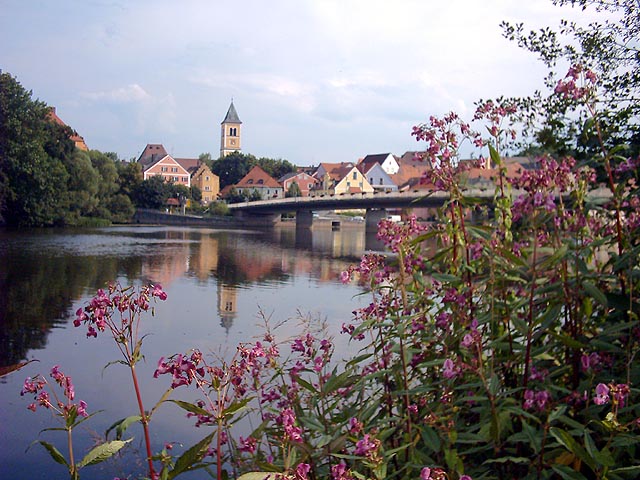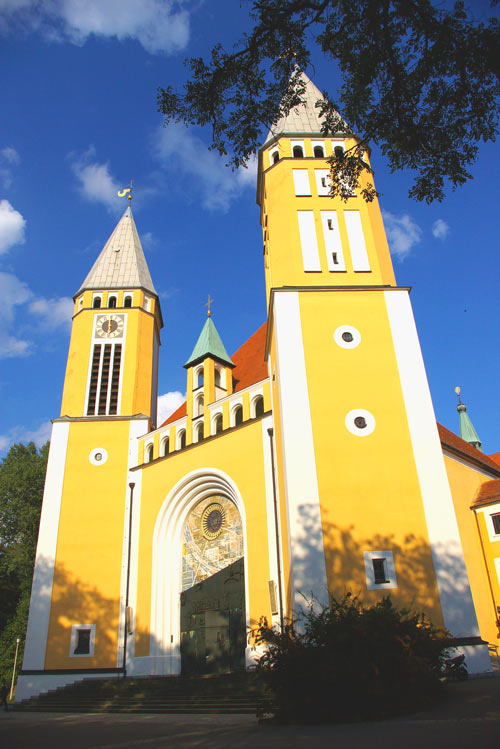|
Schwandorf
Schwandorf is a town on the river Naab in the Upper Palatinate, Bavaria, Germany, which is the seat of the Schwandorf district. Sights * Catholic parish church of St. Jakob * Kreuzberg Church: Catholic parish, monastic and pilgrimage church of Mary Help of Christians on the Kreuzberg Politics Schwandorf (electoral district) Sports The towns association football club, 1. FC Schwandorf, experienced its greatest success in the late 1950s and 1960 when it spent thirteen seasons in the third division Bayernliga. Twin towns – sister cities Schwandorf is twinned with: * Libourne Libourne (; oc, label= Gascon, Liborna ) is a commune in the Gironde department in Nouvelle-Aquitaine in southwestern France. It is a sub-prefecture of the department. It is the wine-making capital of northern Gironde and lies near Saint-Émilio ..., France * Sokolov, Czech Republic References Schwandorf (district) {{Schwandorfdistrict-geo-stub ... [...More Info...] [...Related Items...] OR: [Wikipedia] [Google] [Baidu] |
Schwandorf (electoral District)
Schwandorf is an electoral constituency ( German: ''Wahlkreis'') represented in the Bundestag. It elects one member via first-past-the-post voting. Under the current constituency numbering system, it is designated as constituency 234. It is located in eastern Bavaria, comprising the districts of Cham and Schwandorf. Schwandorf was created for the inaugural 1949 federal election. Since 2021, it has been represented by Martina Englhardt-Kopf of the Christian Social Union (CSU). Geography Schwandorf is located in eastern Bavaria. As of the 2021 federal election, it comprises the districts of Cham and Schwandorf as well as the '' Verwaltungsgemeinschaft'' of Wörth a.d.Donau from the Landkreis Regensburg district. History Schwandorf was created in 1949, then known as ''Burglengenfeld''. It acquired its current name in the 1976 election. In the 1949 election, it was Bavaria constituency 20 in the numbering system. In the 1953 through 1961 elections, it was number 215. In the 1 ... [...More Info...] [...Related Items...] OR: [Wikipedia] [Google] [Baidu] |
Schwandorf (district)
Schwandorf is a ''Landkreis'' (district) in Upper Palatinate in the eastern part of Bavaria, Germany. Neighboring districts are (from the east clockwise) Cham, Regensburg, Neumarkt, Amberg-Sulzbach, Neustadt an der Waldnaab, and the Czech Plzeň Region. Geography The main rivers of the district are the Naab and the Regen. Climate The Climate in this area has mild differences between highs and lows, and there is adequate rainfall year-round. The Köppen Climate Classification subtype for this climate is " Cfb". (Marine West Coast Climate/Oceanic climate). History The district was created in 1972 by merging the previous districts of Burglengenfeld, Oberviechtach, Nabburg, Neunburg vorm Wald, and the previously district-free city Schwandorf. Coat of arms The coat of arms shows the lion of the Palatinate to the left. The tower in the right half symbolizes the many fortresses and castles in the district. The wavy line and the mill wheel in the bottom stand for the many rivers and ... [...More Info...] [...Related Items...] OR: [Wikipedia] [Google] [Baidu] |
Kreuzberg Church, Schwandorf
Kreuzberg Church, Schwandorf (german: Wallfahrtskirche Zu Unserer Lieben Frau vom Kreuzberg) is a Catholic parish church, monastic church and pilgrimage church dedicated to Mary Help of Christians on the Kreuzberg ("Hill of the Cross") in Schwandorf in Bavaria, Germany. History The first chapel on the Kreuzberg was built by the townsfolk between 1678 and 1680 to house an image of the Virgin Mary (a replica of the image of 'Mariahilf' by Lucas Cranach the Elder in Innsbruck Cathedral), and quickly developed as a destination of pilgrimage, to the extent that as early as 1697–1699 the chapel had to be enlarged. Another extension took place in 1784. The Baroque church was almost completely destroyed in a bombing raid in 1945, although the image of Maria remained intact. From 1949 to 1952 it was rebuilt in a modern style. The church serves not only as a place of pilgrimage but also as a parish church and as the church of the nearby Carmelite , image = , capt ... [...More Info...] [...Related Items...] OR: [Wikipedia] [Google] [Baidu] |
Upper Palatinate
The Upper Palatinate (german: Oberpfalz, , ) is one of the seven administrative districts of Bavaria, Germany, and is located in the east of Bavaria. Geography The Upper Palatinate is a landscape with low mountains and numerous ponds and lakes in its lowland regions. By contrast with other regions of Germany it is more rural in character and more sparsely settled. It borders (clockwise from the north) on Upper Franconia, the Czech Republic, Lower Bavaria, Upper Bavaria and Middle Franconia. Notable regions are: * Stiftland, former estate and territorial lordship of Waldsassen Abbey with the market town of Konnersreuth, Fockenfeld Abbey, the town of Waldsassen and about 150 other villages. * Upper Palatine Forest with deep valleys and many castles * Upper Palatine Lake District with the Steinberger See * Upper Palatine Jura, part of the Franconian Jura * Steinwald including the Teichelberg and Pechbrunn * Waldnaab/ Wondreb Depression * Bavarian Forest, together with ... [...More Info...] [...Related Items...] OR: [Wikipedia] [Google] [Baidu] |
Bavaria
Bavaria ( ; ), officially the Free State of Bavaria (german: Freistaat Bayern, link=no ), is a state in the south-east of Germany. With an area of , Bavaria is the largest German state by land area, comprising roughly a fifth of the total land area of Germany. With over 13 million inhabitants, it is second in population only to North Rhine-Westphalia, but due to its large size its population density is below the German average. Bavaria's main cities are Munich (its capital and largest city and also the third largest city in Germany), Nuremberg, and Augsburg. The history of Bavaria includes its earliest settlement by Iron Age Celtic tribes, followed by the conquests of the Roman Empire in the 1st century BC, when the territory was incorporated into the provinces of Raetia and Noricum. It became the Duchy of Bavaria (a stem duchy) in the 6th century AD following the collapse of the Western Roman Empire. It was later incorporated into the Holy Roman Empire, ... [...More Info...] [...Related Items...] OR: [Wikipedia] [Google] [Baidu] |
Naab
__NOTOC__ The Naab ( Czech: ''Nába'') is a river in Bavaria, Germany, and is a left tributary of the Danube. Including its main source river Waldnaab, it is long. Its average discharge at the mouth is . The Naab is formed by the confluence of the Waldnaab and the Haidenaab in Luhe-Wildenau, south of Weiden in der Oberpfalz. It flows generally south, through the towns Nabburg, Schwandorf and Burglengenfeld. It flows into the Danube The Danube ( ; ) is a river that was once a long-standing frontier of the Roman Empire and today connects 10 European countries, running through their territories or being a border. Originating in Germany, the Danube flows southeast for , ... near Regensburg. See also * List of rivers of Bavaria References Sources * ''Die Naab – mit Waldnaab, Fichtelnaab, Haidenaab.'' (2004) Luftbildband, 132 Seiten, Pustet, Regensburg, 2004. * ''Die Naab – Leben am Fluß im Wandel der Zeit.'' (1998) Buch & Kunstverlag Oberpfalz, Amberg,´ ... [...More Info...] [...Related Items...] OR: [Wikipedia] [Google] [Baidu] |
Sokolov, Czech Republic
Sokolov (, until 1948 Falknov nad Ohří; german: Falkenau an der Eger) is a town in the Karlovy Vary Region of the Czech Republic. It has about 22,000 inhabitants. Administrative parts Villages of Hrušková and Novina and area of former village of Vítkov are administrative parts of Sokolov. Etymology The meaning of the original German name ''Falkenau'' was "falcon's riparian forest", the original Czech name ''Falknov'' was created by transcription of the German name. According to legend, it was related to hobby of knight Sebastian, who is said to have been the founder of the town, of falconry. After the World War II, when it was customary to change names of German origin, the town was renamed Sokolov. According to communist propaganda at the time, the name was not related to a falcon (i.e. ''sokol'' in Czech), but to the Battle of Sokolovo in which Czechoslovak soldiers had fought alongside Soviet soldiers on the Eastern Front in World War II. Geography Sokolov is located abou ... [...More Info...] [...Related Items...] OR: [Wikipedia] [Google] [Baidu] |
Bayerisches Landesamt Für Statistik
The statistical offices of the German states ( German: ''Statistische Landesämter'') carry out the task of collecting official statistics in Germany together and in cooperation with the Federal Statistical Office. The implementation of statistics according to Article 83 of the constitution is executed at state level. The federal government A federation (also known as a federal state) is a political entity characterized by a union of partially self-governing provinces, states, or other regions under a central federal government (federalism). In a federation, the self-governin ... has, under Article 73 (1) 11. of the constitution, the exclusive legislation for the "statistics for federal purposes." There are 14 statistical offices for the 16 states: See also * Federal Statistical Office of Germany References {{Reflist Germany Statistical offices Germany ... [...More Info...] [...Related Items...] OR: [Wikipedia] [Google] [Baidu] |
Germany
Germany, officially the Federal Republic of Germany (FRG),, is a country in Central Europe. It is the most populous member state of the European Union. Germany lies between the Baltic and North Sea to the north and the Alps to the south. Its 16 constituent states have a total population of over 84 million in an area of . It borders Denmark to the north, Poland and Czechia to the east, Austria and Switzerland to the south, and France, Luxembourg, Belgium, and the Netherlands to the west. The nation's capital and most populous city is Berlin and its main financial centre is Frankfurt; the largest urban area is the Ruhr. Settlement in what is now Germany began in the Lower Paleolithic, with various tribes inhabiting it from the Neolithic onward, chiefly the Celts. Various Germanic tribes have inhabited the northern parts of modern Germany since classical antiquity. A region named Germania was documented before AD 100. In 962, the Kingdom of Germany formed the ... [...More Info...] [...Related Items...] OR: [Wikipedia] [Google] [Baidu] |
SAD - Kirche St
Sadness is an emotional pain associated with, or characterized by, feelings of disadvantage, loss, despair, grief, helplessness, disappointment and sorrow. An individual experiencing sadness may become quiet or lethargic Lethargy is a state of tiredness, sleepiness, weariness, fatigue, sluggishness or lack of energy. It can be accompanied by depression, decreased motivation, or apathy. Lethargy can be a normal response to inadequate sleep, overexertion, overwor ..., and withdraw themselves from others. An example of severe sadness is Depression (mood), depression, a Mood (psychology), mood which can be brought on by major depressive disorder or persistent depressive disorder. Crying can be an indication of sadness. Sadness is one of the six basic emotions described by Paul Ekman, along with happiness, anger, Surprise (emotion), surprise, fear, and disgust. Childhood Sadness is a common experience in childhood. Sometimes, sadness can lead to Depression (mood), depress ... [...More Info...] [...Related Items...] OR: [Wikipedia] [Google] [Baidu] |
Anti WAA Votivtafel In Schwandorf Kreuzberg
Anti may refer to: *Anti-, a prefix meaning "against" *Änti, or Antaeus, a half-giant in Greek and Berber mythology *A false reading of ''Nemty'', the name of the ferryman who carried Isis to Set's island in Egyptian mythology *Áńt’į, or corpse powder, Navajo folkloric substance made from powdered corpses *ANTI – Contemporary Art Festival, a yearly international live-art festival held in Kuopio, Finland *Antiparticle, a particle with the same mass but opposite charges in particle physics *Anti addition, a type of bonding in organic chemistry *Anti conformation, an arrangement of atoms in alkane stereochemistry *ANTI (computer virus), a classic Mac OS computer virus Music *Anti- (record label), an American independent record label * ''Anti'' (album), an album by Rihanna *''Anti EP'', an EP by Autechre * "Anti" (song), a song by SOB X RBE *''Anti'', an album by T. Raumschmiere People *Anti (given name), an Estonian masculine given name *Carlo Anti (1889–1961), Italian arc ... [...More Info...] [...Related Items...] OR: [Wikipedia] [Google] [Baidu] |



